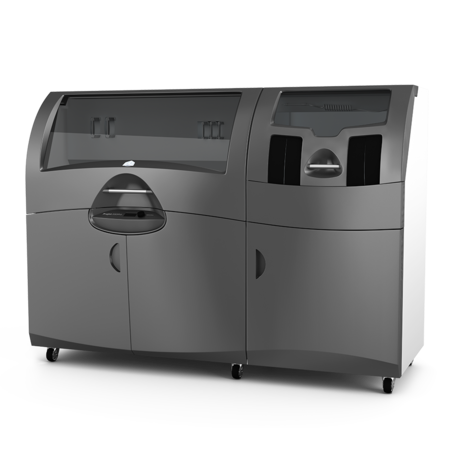Some underwater jobs are too dangerous, expensive or ambitious for a manned submarine: scouring a harbor for explosives, inspecting the nether regions of an oil rig or, perhaps someday, exploring life in the liquid beneath the ice layer on a Jovian moon. This is why NASA recently gave Norwich University of Northfield, Vt., a grant to develop an autonomous underwater vehicle (AUV).
It's an ambitious project for busy students. To save time, money and labor, and to employ innovative production techniques, the university AUV team is "3D printing" many of the vehicle's parts. This demonstrates the durability and performance, even in underwater competition, of parts that can be rapidly manufactured from 3D CAD data.
Challenge
A Thinking Vehicle
Don't gloss over the A in AUV. Autonomous means the vehicle actually perceives obstacles and targets it encounters, distinguishes between them, recognizes what it's looking for, and decides which actions to take. Unlike a manned or remotely operated vehicle, you just toss it in the water, back off, and let it do its work.
AUVs in the 11th International Autonomous Underwater Vehicle Competition in San Diego navigate an underwater pipeline by an unmanned vision in the Norwich vehicle's case, using two cameras and a digital compass. It finds target bins, drops markers into them and retrieves "treasures" specified by the judges.
Preparing for these steep challenges consumed the better part of 2008 for three mechanical engineering and seven computer engineering students known as the Bot Rodders. The result is the Poseidon, a 34 x 15 x 15-inch vehicle weighing about 30 pounds and propelled by a unique drive system. The Poseidon uses one propeller instead of the five or six that deep-pocketed teams use, and the single propeller's force is yoked by a series of directional nozzles on the corners of the craft, any combination of which is activated for a particular maneuver. "Our design means far less battery mass, making Poseidon nimbler, greener and more economical," said senior mechanical engineering major and co-team leader Ryan Wood.
Strategy
"3D Printing" Custom Parts
While many rival teams' AUV entries are slight modifications of designs from previous annual competitions, 2008 is the first year of competition for Norwich, meaning the Bot Rodders approached their design from scratch. "We had to teach ourselves what every other team had done, how each design had performed, and where we could find an advantage," said team member Blake Shaffer, a senior mechanical engineering major.
The Poseidon's unique design required a host of custom parts that the Bot Rodders designed in Kubotek USA's KeyCreator™ 3D CAD software. Ordinarily, a student would turn to the school's machine shop to make them. But the team decided to try a faster, simpler and easier route. They opted to use the school's 3D printer, a ProJet CJP 360, to manufacture the parts.
The 3D printer uses inkjets to bind composite powder into solid physical parts, giving substance to electronic 3D CAD models. 3D printed parts can be drilled, tapped, sanded and painted or electroplated to replicate the look and feel of the final product. To make parts waterproof, Bot Rodders dip them in Epolam epoxy.
Students first discovered 3D printing in their manufacturing classes where they prototyped parts for their junior projects. Now they are making production-quality parts that can withstand prolonged immersion.
"We read the application note, tried it for ourselves and it worked," said Wood. "We're now using 3D printed parts as mounts for servo motors and as a pod for our passive sonar 'hydrophones,' which help Poseidon navigate."
Results
Time and Money Saved
In addition to pushing the boundaries of manufacturing technology, the team simply would not have been able to make the highly complex parts in the school's machine shop. In instances where the tools were available, time constraints made manual fabrication impossible. Although the team could have outsourced the fabrication, it opted to invest that budget in the Poseidon's electronics.
"That a 'prototype' could be dipped into the hardener and used as the final part was too good to be true," said Shaffer. "It was by far the fastest and easiest way to move from the CAD model to the finished part." The team probably saved more than $5,000 and several months of manufacturing time using the printer to make the parts, according to mechanical engineering Associate Professor R. Danner Friend, the team's advisor.
The team also used the Color Jet printer (CJP) in the creation of end caps for the cylinders in the main vehicle body. Students 3D printed a "mold mold," poured in a rubber-like material to create a main mold, poured a two-chemical plastic into that, lifted out the finished parts, and applied them to the craft.
"We're pushing the envelope of 3D printing by using 3D printouts as final parts, and we expect the industry to move in this direction over the next decade," said Wood. "That's good for me as a future job applicant who can legitimately claim significant and meaningful experience with new manufacturing technology."
Norwich originally discovered 3D printing five years ago and invested in the technology to supplement its machine shop. The school chose the ProJet CJP 360 because its speed, affordability and non-hazardous materials made sense in the classroom. In addition to being the world's fastest 3D printer, it uniquely allows users to "nest" parts inside the build chamber and print out an entire class's projects in a few hours. Students are astonished at the speed, initially expecting to wait a week or so for models.
"We have steadily increased use of the 3D printer over the five years that we've had the machine," said Friend. "It's been a workhorse. We've gone far beyond our initial expectations by using it for real, usable products, and we plan to further investigate its possibilities in alternative manufacturing processes going forward. It's an exciting area."
